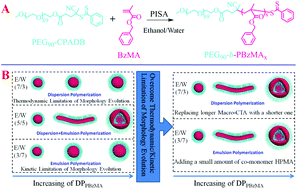Influence of solvent on the RAFT-mediated polymerization of benzyl methacrylate (BzMA) and how to overcome the thermodynamic/kinetic limitation of morphology evolution during polymerization-induced self-assembly†
Abstract
Polymerization-induced self-assembly (PISA) has been demonstrated to be a powerful strategy to produce polymeric nano-objects of various morphologies. Dependent on the solubility of monomers, PISA is usually classified into two formulations as dispersion polymerization or emulsion polymerization, which may undergo quite different processes of polymerization and morphology transition. Generally, chain propagation of the solvophobic blocks will induce the morphology transition of the nano-objects from spherical micelles to higher order morphologies. However, the limitation of morphology evolution is often observed during PISA, and how to overcome the trapped spherical micelles obviously depends on case-by-case analysis. Herein, RAFT-mediated PISA of benzyl methacrylate (BzMA) in different formulations is investigated by varying the solvent composition (the mass ratio of ethanol/water). The polymerization kinetics, nucleation, and morphology transitions are quite different between these different PISA formulations. The morphology transition of spherical micelles, to worm-like micelles, and finally to vesicles is only observed at a moderate ratio of ethanol/water (5/5, w/w). At either a higher ratio of ethanol/water (7/3, w/w) or lower ratio of ethanol/water (3/7, w/w), morphology transitions of spherical micelles to the higher order ones are both limited, but the limited morphology transitions are caused by a different mechanism. The entrapped spherical micelles at ethanol/water = 7/3 (w/w) are determined by thermodynamic factors, and morphology transition can be achieved by using a shorter solvophilic polymer as the macro-RAFT agent, while the spherical micelles obtained at ethanol/water = 3/7 (w/w) are kinetically trapped, which can be overcome by copolymerization of some other monomers to improve the flexibility of solvophobic blocks. This work is promising as it provides a principle to overcome the limitations of morphology evolution in different cases and develops the design for formulations of PISA.



 Please wait while we load your content...
Please wait while we load your content...